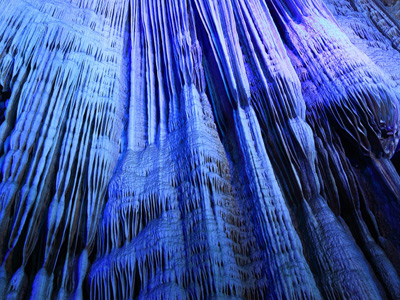
Ask the AI Tutor
Need help with Limestone Scenery 01? Ask our AI Tutor!
AI Tutor - Lucy
Connecting with Tutor...
Please wait while we establish connection

'Icicles' on the roof of a limestone cave have what name?
Limestone Scenery 01
Limestone landscapes are full of caves, cliffs and disappearing streams. This KS3 Geography quiz explores how limestone is formed, shaped by weathering and erosion, and used by people.
1 .
What type of rock is limestone?
Igneous
Metamorphic
Punk
Sedimentary
Thick sediments were squashed together over time
2 .
Which hobby is popular in limestone regions?
Parachuting
Potholing
Skiing
White water rafting
Rock climbing on limestone cliffs and walking through limestone scenery are also very popular
3 .
Bare rock outcrops are called limestone…what?
Kerbs
Pavements
Ridges
Shelves
Limestone pavement consists of clints and grykes but do you know which is which?
4 .
What is limestone made of?
Calcium carbonate
Calcium chloride
Calcium dioxide
Calcium sulfide
There are other materials in there too like particles of mud, but it is mainly calcium carbonate
5 .
'Icicles' on the roof of a limestone cave have what name?
Dolomites
Stalactites
Stalagmites
Stalinites
Formed from drops of water containing dissolved limestone. As the drops slowly evaporate, the dissolved limestone is precipitated out and so the stalactite slowly grows
6 .
Which area has spectacular limestone landscapes?
Dartmoor
Lake District
Snowdonia
Yorkshire Dales
The scenery is a big tourist attraction to the area. There are other ares of the UK in which Carboniferous limestone can be found
7 .
Which of these words best describes limestone?
Impervious
Permafrost
Permeable
Volcanic
Permeable means it lets water through. It is permeable because it contains lots of cracks and rainwater can dissolve it, widening the cracks
8 .
During which of the following geological periods was limestone formed?
Cambrian
Carboniferous
Palaeocene
Permian
This is referred to as Carboniferous limestone and is the type that gives rise to spectacular landscape features. There is also limestone formed more recently during the Jurassic period, which is interesting in its own right but without the dramatic features of the Carboniferous limestone
9 .
Gaping Gill is an excellent example of what feature?
Gorge
Stalagmite
Swallow hole
Tufa screen
It's in North Yorkshire
10 .
Why do limestone areas usually have a dry surface?
Local villages use all the rainwater
Streams disappear underground
Surface water evaporates quickly
They have very low rainfall
This is why limestone has underground features like potholes and caves
**Unlimited Quizzes Await You! 🚀**
Hey there, quiz champ! 🌟 You've already tackled today's free questions.
Ready for more?
Ready for more?
🔓 Unlock UNLIMITED Quizzes and challenge yourself every day. But that's
not all...
not all...
🔥 As a Subscriber you can join our thrilling "Daily Streak" against other
quizzers. Try to win a coveted spot on our Hall of Fame Page.
quizzers. Try to win a coveted spot on our Hall of Fame Page.
Don't miss out! Join us now and keep the fun rolling. 🎉
**Unlimited Quizzes Await You! 🚀**
Hey there, quiz champ! 🌟 You've already tackled today's free questions. Ready for more?
🔓 Unlock UNLIMITED Quizzes and challenge yourself every day. But that's not all...
🔥 As a Subscriber you can join our thrilling "Daily Streak" against other quizzers. Try to win a coveted spot on our Hall of Fame Page.
Don't miss out! Join us now and keep the fun rolling. 🎉






